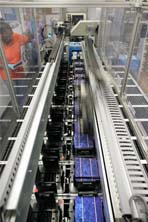Is PV pricing finally stabilizing?
 At least one analyst is starting to see signs that solar photovoltaic (PV) manufacturing is coming closer to meeting—not exceeding demand. If so, it could help the industry recover from the gyre they’ve in for the last two-to-three years.
At least one analyst is starting to see signs that solar photovoltaic (PV) manufacturing is coming closer to meeting—not exceeding demand. If so, it could help the industry recover from the gyre they’ve in for the last two-to-three years.
Right now the beleaguered industry has suffered from too many manufacturers across the world boosting their production too quickly. The overproduction meant more companies fought for the same market share causing module price drops and oversupply.
That’s starting to change, according to Citigroup analyst Timothy Arcuri. “I think there’s a meaningful inventory that’s been worked down, inventories now are quite low.” He anticipated that there will continue to be some price drops in polysilicon PV prices, but that prices for mono-crystalline silicon will level out.
Some of the inventory drops are related manufacturing reductions, but also there is some increased activity in Europe as people and companies are trying to catch the tail-end of incentive programs that are falling off.
Demand will also be soaked up as Japan launches its feed-in tariff in July, which will pay roughly $42 cents per kilowatt hour for power produced by PV arrays. “It’s one of the highest, if not the highest in the world,” Arcuri said.
Demand will also come from the two largest nations, India and China. A lot of news about new solar installations has been coming out of India, but China has been quieter. That being said, China is expected to install about 4.5 gigawatts of solar this year, according to Arcuri.
Chinese demand could help offset the impact of oversupply. “The way I think about China is it’s a big demand sink. It’s a big sink for product,” Arcuri said. “The product happens to be primarily Chinese. i don’t think anyone’s going to make a lot of money in China, but it s soaks up supply at very thin margins.”
Arcuri’s research spurred him to make ratings changes on both Sunpower (from hold to buy) and for Yingli Green Energy (from sell to buy). Other companies, including First Solar (hold) remained in the same position. “It’s gong to be challenging for them. I think they will be much better off being a project developer not so married to their own module,” he said. He cited lower efficiencies and problems in the field.
Image courtesy of NREL



